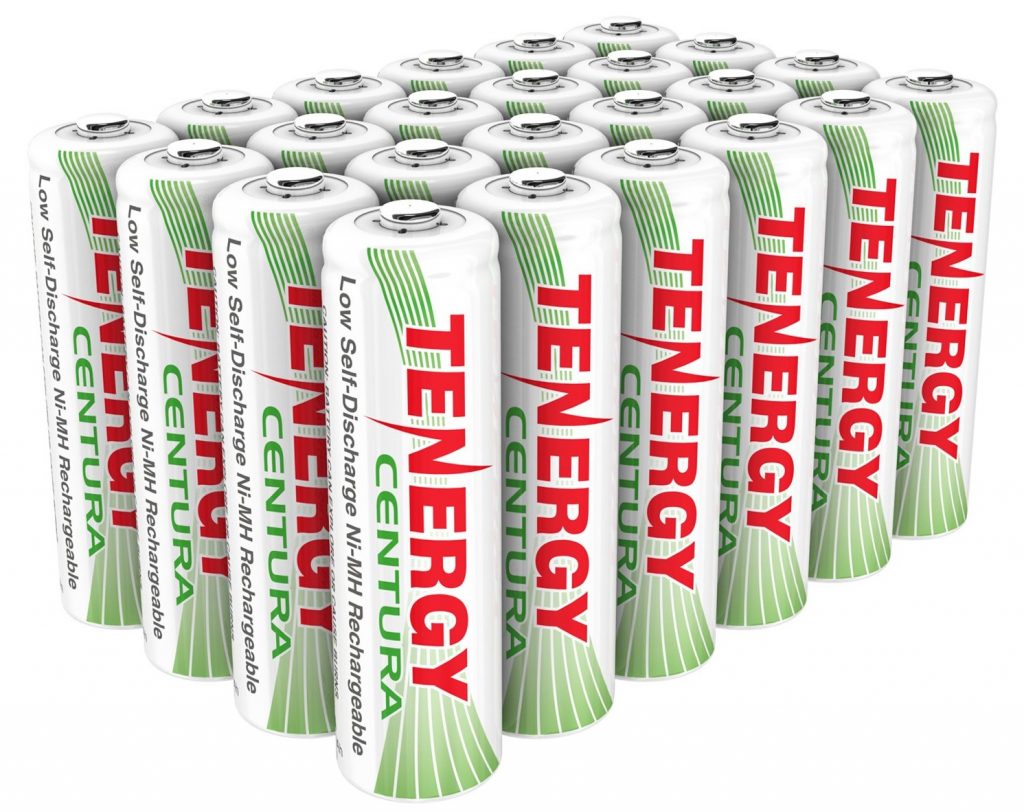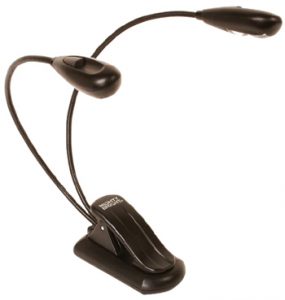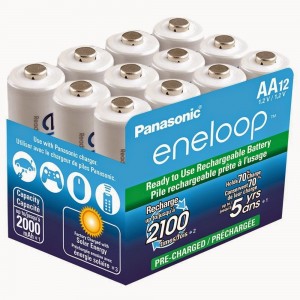Many thanks to SWLing Post contributor, Troy Riedel, who recently shared his observations about low self-discharge batteries with me. He has kindly allowed me to post his message here on the SWLing Post. Troy notes:
I’ve lauded Tenergy rechargeable NiMH batteries and I wanted to share something with you.
I have a box of Mighty Bright combination Red & White LEDs that I use for astronomy (they’re a clip-on light used by pilots and also marketed for use in the automobile – they hold three AAAs).
Approx. 18-months ago I put fully charged Rayovac, Energizer, Eneloop & Tenergy Centura Low Self-Discharge batteries in them.
Last night I pulled them out.
Rayovac: 0% charge.
Energizer: 0% charge
Tenergy Centura LSD & Eneloop: both averaged ~ 70% of a charge … (6 batteries in two lights) … though some of the Eneloops had a slightly higher charge (maybe 2 – 5% higher), most of the batteries were virtually indistinguishable.You can buy 8 Tenergy for $9.99 while 8 Eneloop cost $17.99.
If cost were not an issue I’d still go with Eneloop (a longer track record), but the Tenergy is a worthy – no, very worthy – value vs. performance choice.
Thanks for sharing your real-world feedback, Troy.
I’m a big believer in low self-discharge rechargeable batteries. Indeed, I’ve almost replaced all of our “legacy” (meaning not low self-discarge) NiMH AA and AAA batteries with Eneloop cells.
Eneloops are pretty pricey, though, and the costs add up if you have a lot of devices that require batteries. As you might imagine, portable radios demand a steady supply of AA batteries at SWLing Post HQ.
I’ve been very pleased with my Eneloop batteries and, frankly, haven’t switched brands because of the terrible luck I’ve had with “legacy” rechargeables in the past. I’ve purchased so many that worked wonderfully for a few months then began to lose their capacity even though I employ an intelligent charger that properly breaks-in and cycles them.
I do believe I’ll add some Tenergy AA and AAA batteries in the mix now–especially for non-radio applications like lighting, remotes, clocks, and other consumer electronics.
Click here to check out Tenergy batteries and click here to check out Eneloop batteries at Amazon.com (affiliate links support the SWLing Post).
What are your observations?
Have you used Tenergy and Eneloop batteries? What about other brands? Please share your thoughts by leaving a comment on this post.




Where can I find 8 Tenergy Centura for $9.99 (or even 8 Eneloops for $17.99) like the article says?
I’ve been using NiCads and NiMH batteries for ages with smart chargers that can monitor their capacity and performance.
The only brand that performs to spec are the Eneloops and the high capacity pro Powerex cells. I’ve Eneloop AAs that are years old and they’re still performing well, never had one fail. There’s good reason to believe the Amazon basic AA cells that were made in Japan are rebranded Eneloops and I’ve had very good results with them. However, the latest Amazon basic AA cells appear to be made in China. There’s also very good reason to believe that the Ikea LADA AA cells are rebranded high capacity Eneloops and therefore very good value indeed at the price Ikea sells them for.
As for Tenergy batteries, I bought some of their AA cells around 10 years ago that were rated at 2600 mAh (the reason I bought them since they were cheap). In actual fact their capacity was no more than 1600 mAh and in due course they failed and I’ve never bought another Tenergy battery since.
Over the years I’ve used many different brands of NiMH, with the exception of Eneloops and the rebranded versions, every one of them has failed, and not through misuse since I know how to treat them well. All those high-capacity Chinese AA cells rated 2700 mAh and above are misrepresented. You’ll see cells on Amazon rated at 2800 mAh and even 3000 mAh, I recently bought four AA cells rated at 3000 mAh for $6.00 from Amazon just to see what their actual capacity was. They were actually 2000 mAh as determined in my smart charger. In truth the maximum capacity NiMH cells the technology is capable of is currently 2700 mAh and those are the Powerex high capacity pro AA cells. Those Powerex 2700mAh cells are expensive but perform to spec.
Last I read there was only one factory in Japan that makes NiMH batteries and that’s owned by Sanyo who make the Eneloop cells. The Powerex AAs are also made in Japan so they’re likely coming out of the same factory as the Eneloops. The only downside to those Powerex cells is that they’re not true LSD. They perform best being constantly charged and used, not charged and left on a shelf for a while. There’s a trade-off involved in going to higher capacity cells, they discharge at a higher rate, they have fewer charge cycles over their useful lifespan (500 vs. >2000) and they appear to be less robust and less tolerant of misuse.
Amazon appear to have recently re-configured their Basic brand of cells.
I recently bought 4 C-size Amazon basic cells rated at 5000 mAh. I checked their capacity in my charger and they were all coming in at slightly over 5000 mAh, so they’re at spec. Compare that with the Energizer C-size cell rated at 2500 mAh where they basically stuck an AA cell in a C-cell casing and raised the price. My experience with Energizer batteries is not good, all the Energizer AA cells I’ve owned failed after little use.
Also recently bought 4 D EBL cells rated at 10,000 mAh for an LED lantern I use. Checking them in my charger they’re no more than around 7500 mAh. So, EBL appear to be significantly inflating the capacity of their NiMH D cells.
Powerex have recently updated their 8 AA cell charger and I bought one over Christmas. This is now my “go to” AA charger. I don’t know what kind of charging algorithm they’re using but it seems to charge the cells very reliably and consistently and it also has a conditioning program that appears to work very well to “refresh and awaken” older, sluggish cells.
https://www.amazon.com/Powerex-MH-C980-Charger-Analyzer-Batteries/dp/B07QYCJKJK/ref=sr_1_6?crid=2SS15GC0W0TAQ&keywords=powerex+aa+charger&qid=1580778832&sprefix=powerex+aa+%2Caps%2C827&sr=8-6
My previous main two chargers were the Powerex MH-C9000 and the La Crosse Technology BC1000. I also have a bunch of other chargers as well since I’m kind of fascinated by rechargeable battery technology.
In summary, the only brands of NiMHs I trust are the Enenloops (LADA AAs?), the Amazon Basics brand and the Powerex high capacity pro cells. In my experience, all the others brands I’ve used have either inflated capacity ratings and/or are poor quality and fail after little use.
Tenergy batteries are great! I’ve been using them for years and they perform very well. I highly recommend them.
I just bought NIMH low discharge batteries from IKEA recently and they’re very recommendable. 10 pcs for 12€.
Those Ikea cells are almost certainly rebranded high-capacity Eneloops and at the price Ikea is selling them for they represent excellent value.
I must say I have been an eneloop fan for some time – too many alkaline disasters in the last ten years or so. I may try the Tenergy Centuras in non-critical devices as a test. I am wary because of finding discharged states when I need something immediately, but certainly willing to give them a try. Thanks for the posting! Robert
I didn’t mention this in my note to Thomas, but I have 2 shortwave radios that have Tenergy Centura Low Self Discharge NiMH AA size in them … I tend to put the Tenergy Centura and Eneloop in radios that tend to “sit” unused for prolonged periods (I have ~ 17 portables). The Tenergy Centura AA perform similarly to the AAAs (noted above) compared to Eneloop.
I’ve had surprisingly good results with EBL “C” & “D” NiMH. They hold their charge a long, long time when stored and when in regular use. The Energizer “C” & “D” size are HORRIBLE (they are AA batteries put inside a “C” and “D” shell as evidenced by their weight – both weigh the same as the AA – and their low mAh ratings).
Lastly, I sometimes rotate and use EBL AA in a Celestron SLT tracking (aka “Go To”) mount with my 120mm Refractor Telescope. I have never formally tested them, but I find the 2300 mAh outperform the 2800 mAh. One should note, the EBL 2300 mAh are labeled “Ready to Use” whereas the 2800 mAh are labeled “Ready to Charge”. I suspect the 2300 mAh batteries may be LSD and the 2800s are not – again, that’s only a guess.
I haven’t counted, but between my radios and my astronomical equipment (incl. the red LED flashlights), I always have *over* 100 rechargeable NiMH in use plus about 40 others as standbys (Tenergy Centura, Eneloop, EBL, Energizer, Radio Shack, two different generations of Rayovac, Duracell, Amazon Basics & Eveready) – and this does not count the 3-dozen no-names that I’ve long since recycled. I have two reconditioning chargers that (1) identify bad cells; and (2) they have a discharge mode to completely deplete a charge before a recharge cycle begins. Suffice it to say: as I need to replace or add NiMH batteries, I purchase Eneloop & Tenergy Centura LSDs in AAA & AA, EBL in C & D, and Tenergy Centura LSD 9-Volts are in ALL 7 of my smoke detectors plus 2-3 shortwave antennae.
Note that the article is specifically referencing the Tenergy CENTURA line batteries and not the other Tenergy models like the Premium (that don’t appear to be low self-discharge).
I’ve never used Tenergy but they’ve been around a while and heard decent things about them as a brand in general.
I’ve use the Amazon Basics LSD and also tried the Ikea LADDA (supposedly LSD.. doesn’t say on the packaging but boasts “ready to use”) and both seem to be “almost” as good as the the Eneloops. They just don’t seem to hold quite as much of a charge on the shelf.
I have noticed that the newest AmazonBasics AAA LSD’s appear to be made in China. The older Amazon Basics LSD’s. LADDA’s and Eneloops are made in Japan. Haven’t seen any performance difference yet, but will keep my eye on it.
Thank you! I’ve corrected this in the post.
Thomas, I have not tried the Tenergy Batteries yet, although I have looked into them. I have had so much luck with the Black Eneloops that I have pretty much gone to them almost exclusively. They are pricey, but I have found them to be the most reliable. I would like to hear some of your reports on the Tenergy’s as you work them into your rotation.
Tnx & 73’s
Jack Blanke
Metairie, LA